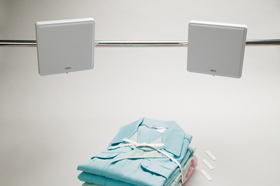Archived content
NOTE: this is an archived page and the content is likely to be out of date.
Fujitsu Begins Worldwide Sales of UHF-Band RFID Tags for Garment Management
-Superior durability and flexibility make it unnecessary to detach tags when washing, and multiple tags can be read simultaneously, enabling efficient management-
Fujitsu Limited,Fujitsu Frontech Limited
Tokyo, May 12, 2008
Fujitsu Limited and Fujitsu Frontech Limited announced that they are expanding sales of UHF-band(1) RFID tags for garment management to markets outside Japan, beginning today. Small, thin and boasting superior durability, the tags will be marketed primarily in North America, Europe, and China.
Fujitsu RFID garment tags combine thinness with superior durability, strength and flexibility. The waterproof tags can withstand heat, bending and pressure during washing, and in addition, because of their small size and softness, they can be attached to a wide variety of fabrics and garments without compromising the comfort of the garment wearer. With their UHF-band capabilities, multiple contactless tags can be read simultaneously, raising operational efficiency.
In addition to the garment tags compatible with bandwidth frequencies used in Japan, Fujitsu will begin sales of tags for markets outside of Japan, including North America, Europe, and China.
 RFID garment tag with superior durability and flexibility
RFID garment tag with superior durability and flexibility
Background
Fujitsu and Fujitsu Frontech initially developed RFID garment tags for the Japanese market. The companies have now successfully developed RFID garment tags that are widely compatible with bandwidth frequencies outside of Japan, enabling an expansion of sales to worldwide markets. The tags can be recorded with information unique to each tagged item, and by attaching the tags to garments and fabrics, tracking(2) of each tagged item is achieved. Not only can the location of each item be tracked, additional information such as the number of times an item has been used or the period of time it has been in use can also be managed, enabling efficient and accurate management of inventories.
The newly developed RFID garment tags feature the same durability and flexibility as the tags used in Japan. Fujitsu is launching sales of two model types: the A501, which have a pre-defined Electronic Product Code (EPC)(3) input by Fujitsu, and the A601, which can have customized code input by customers. With the A601 model, users can customize the field codes to manage their products in accordance with detailed category characteristic, including such information as product type, color, and size. Based on its foresight in developing the world's first UHF-band RFID garment tag and its track record in Japan, Fujitsu is now working with local partners in the RFID field around the world to bring these garment tags to organizations such as hotels and amusement parks in North America, Europe, and China.
The RFID tags were developed by Fujitsu and Fujitsu Frontech and are being manufactured by Fujitsu Frontech.
 Reading system for RFID garment tags
Reading system for RFID garment tags
Features of the RFID Tags
- Compatible with international standards, making system set-up easy
The tags are compliant with ISO/IEC 18000-6 Type C international standard for UHF-band RFID [EPCglobal(4) Class1 Generation2(5)], so they can be read by standard reader-writer equipment and antennas, making system set-up easy. In addition, with their UHF-band capabilities, multiple contactless tags can be simultaneously read, raising operational efficiency.
- Suitable for a variety of environments while maintaining high durability
The tags are waterproof and resistant to pressure, heat, and alkaline washing, designed to withstand tough environmental conditions through 200 cleaning cycles (washing, drying, and ironing). Moreover, they are thin but flexible, so they can be attached to any type of clothing or fabric without causing discomfort to the garment wearer.
- Compatible with a wide range of bandwidth frequencies used outside of Japan
The tags are designed so that they can be read at a set transmission distance, even though bandwidth frequencies can differ among countries, enabling them to be used to track products in different regions or across borders.
Main Product Applications
| Garments and fabrics |
: |
Uniforms, work clothes, mops, linens, canvas bags, etc. |
| Plastic products |
: |
Pallets, containers, etc. |
Pricing and Availability
| Tag Type |
Pricing |
Start Sales |
Start Shipment |
| Garment tag type A501 |
Per order |
Immediate |
Early July, 2008 |
| Garment tag type A601 |
Per order |
Immediate |
Early July, 2008 |
Main Specifications
|
| Garment Tag Model A501 |
Garment Tag Model A601 |
| RFID Standard |
ISO/IEC 18000-6 Type C (EPC Gen2) compliant |
| Dimensions and weight |
60(W)x15(D)x1.6(H)mm, 2g |
| EPC Number Area |
96bit (code area set by Fujtisu) |
96bit (code area not input) |
| Frequency |
866-868MHz, 902-928MHz |
| Reading Range |
866-868MHz |
2WERP : 1.0m (typical) |
| 902-928MHz |
4WEIRP : 1.3m (typical) |
| Usage Environment |
-20 to 50°C, 10 to 95%RH (no condensing) |
| Storage Environment |
-40 to 55°C, 8 to 95%RH (no condensing) |
| Lifetime |
3 years or 200 washes, whichever is less |
| Durability |
Heat resistant (ironing, dryers), pressure resistant, alkaline resistant, waterproof |
Target Sales
5 billion yen over three years.
About Fujitsu
Fujitsu is a leading provider of IT-based business solutions for the global marketplace. With approximately 160,000 employees supporting customers in 70 countries, Fujitsu combines a worldwide corps of systems and services experts with highly reliable computing and communications products and advanced microelectronics to deliver added value to customers. Headquartered in Tokyo, Fujitsu Limited (TSE:6702) reported consolidated revenues of 5.3 trillion yen (US$53 billion) for the fiscal year ended March 31, 2008. For more information, please see: www.fujitsu.com.
About Fujitsu Frontech
As part of the Fujitsu group, Fujitsu Frontech Limited develops, manufactures and sells products such as ATMs, operation branch terminals, POS terminals, public display devices and offers related software, system integration and outsourcing as part of its total solutions offerings. The company also supports the security sector by offering products incorporating Fujitsu's latest palm vein authentication technology. Fujitsu Frontech is actively involved in the development of key technologies in various fields and is currently focusing on the areas of color electronic paper and service robots. For more information, please see: http://www.frontech.fujitsu.com/en/
Press Contacts
Public and Investor Relations Division
Inquiries
Company:Fujitsu Limited
Customer Contacts
Global Business Development Division
Inquiry
Company:Fujitsu Frontech Limited
Company and product names referenced herein are trademarks or registered trademarks of their respective owners. Information provided in this press release is accurate at time of publication and is subject to change without advance notice.
Date: 12 May, 2008
City: Tokyo
Company:
Fujitsu Limited,
Fujitsu Frontech Limited,
,
,
,

